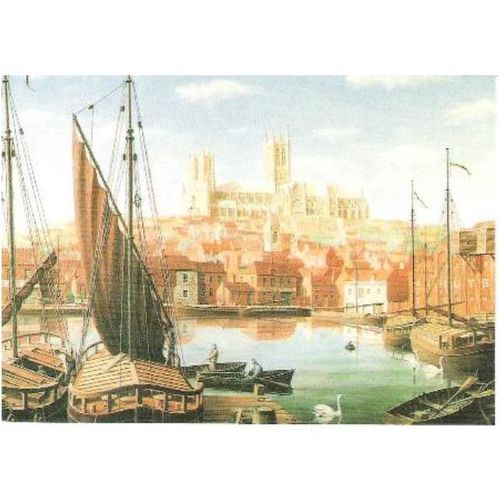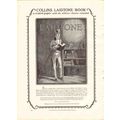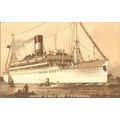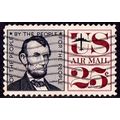Lincoln Cathedral - from Brayford Pool - art postcard 1990
- Condition : Used
- Dispatch : 2 Days
- Brand : None
- ID# : 128323386
- Quantity : 1 item
- Views : 305
- Location : United Kingdom

- Seller : justthebook (+1699)
- Barcode : None
- Start : Mon 19 May 2014 20:17:29 (BST)
- Close : Run Until Sold
- Remain : Run Until Sold
More Listings from This Seller view all
Seller's Description
- Postcard
- Picture / Image: Lincoln Cathedral from Brayford Pool, Lincolnshire - art postcard by John Bangay, 1990
- Publisher: Lincoln Cathedral
- Postally used: no
- Stamp: n/a
- Postmark(s): n/a
- Sent to: n/a
- Notes / condition:
Please ask if you need any other information and I will do the best I can to answer.
Image may be low res for illustrative purposes - if you need a higher definition image then please contact me and I may be able to send one.
------------------------------------------------
Postage & Packing:
UK (incl. IOM, CI & BFPO): 99p
Europe: £1.60
Rest of world (inc. USA etc): £2.75
No additional charges for more than one postcard. You can buy as many postcards from me as you like and you will just pay the fee above once. (If buying postcards with other things such as books, please contact or wait for invoice before paying).
Payment Methods:
UK - PayPal, Cheque (from UK bank) or postal order
Outside UK: PayPal ONLY (unless otherwise stated) please. NO non-UK currency checks or money orders (sorry).
NOTE: All postcards are sent in brand new stiffened envelopes which I have bought for the task. These are specially made to protect postcards and you may be able to re-use them. In addition there are other costs to sending so the above charge is not just for the stamp!
I will give a full refund if you are not fully satisfied with the postcard.
----------------------------------------------
Text from the free encyclopedia WIKIPEDIA may appear below to give a little background information (internal links may not work) :
*************
Lincoln Cathedral (in full The Cathedral Church of the Blessed Virgin Mary of Lincoln, or sometimes St. Mary's Cathedral) is a cathedral located in Lincoln in England and seat of the Bishop of Lincoln in the Church of England. Building commenced in 1088 and continued in several phases throughout the medieval period. It was reputedly the tallest building in the world for 238 years (1311–1549).[1][2][3] The central spire collapsed in 1549 and was not rebuilt. It is highly regarded by architectural scholars; the eminent Victorian writer John Ruskin declared: ""I have always held... that the cathedral of Lincoln is out and out the most precious piece of architecture in the British Isles and roughly speaking worth any two other cathedrals we have.""
Remigius de Fécamp, the first bishop of Lincoln, moved the Episcopal seat there ""some time between 1072 and 1092""[4] About this, James Essex writes ""Remigius ... laid the foundations of his Cathedral in 1088"", and ""it is probable that he, being a Norman, employed Norman masons to superintend the building ... though he could not complete the whole before his death.""[5] Before that, writes B. Winkles, ""It is well known that Remigius appropriated the parish church of St Mary Magdalene in Lincoln, although it is not known what use he made of it.""[6]
Up until then St. Mary's Church in Stow was considered to be the ""mother church""[7] of Lincolnshire[8] (although it was not a cathedral, because the seat of the diocese was at Dorchester Abbey in Dorchester-on-Thames, Oxfordshire). However, Lincoln was more central to a diocese that stretched from the Thames to the Humber.
Bishop Remigius built the first Lincoln Cathedral on the present site, finishing it in 1092 and then dying on 9 May of that year,[9] two days before it was consecrated. In 1141, the timber roofing was destroyed in a fire. Bishop Alexander rebuilt and expanded the cathedral, but it was mostly destroyed by an earthquake about forty years later, in 1185 (dated by the BGS as occurring 15 April 1185).[6][10] The earthquake was one of the largest felt in the UK: it has an estimated magnitude of over 5, with a magnitude of 7 estimated in certain locations.[10] The epicenter of the earthquake is debated: some (Throsby, 1790; Mayfield, 1976; Beresford, 1987), think it may have been in Nottinghamshire, where it completely destroyed several villages.[10] Others (Davison, 1931) estimate the epicenter was in the North Sea, as the quake was also felt in Norway.[10] The damage to the cathedral is thought to have been very extensive: the Cathedral is described as having ""split from top to bottom""; in the current building, only the lower part of the west end and of its two attached towers remain of the pre-earthquake cathedral.[10] Some (Kidson, 1986; Woo, 1991) have suggested that the damage to Lincoln Cathedral was probably exaggerated by poor build quality or design; with the actual collapse most probably caused by a vault collapse.[10]
After the earthquake, a new bishop was appointed. He was Hugh de Burgundy of Avalon, France, who became known as St Hugh of Lincoln. He began a massive rebuilding and expansion programme. Rebuilding began with the choir (St. Hugh's Choir) and the eastern transepts between 1192 and 1210.[11] The central nave was then built in the Early English Gothic style. Lincoln Cathedral soon followed other architectural advances of the time – pointed arches, flying buttresses and ribbed vaulting were added to the cathedral. This allowed the creation and support of larger windows. The cathedral is the 3rd largest in Britain (in floor space) after St Paul's and York Minster, being 484 feet (148 m) by 271 feet (83 m). It is Lincolnshire's largest building, and until 1549 the spire was reputedly the tallest medieval tower in Europe, though the exact height has been a matter of debate. Accompanying the cathedral's large bell, Great Tom of Lincoln, is a quarter-hour striking clock. The clock was installed in the early 19th century.
There are thirteen bells in the south-west tower, two in the north-west tower, and five in the central tower (including Great Tom).[12] The two large stained glass rose windows, the matching Dean's Eye and Bishop's Eye, were added to the cathedral during the late Middle Ages. The former, the Dean's Eye in the north transept dates from the 1192 rebuild begun by St Hugh, finally being completed in 1235. The latter, the Bishop's eye, in the south transept was reconstructed 100 years later in 1330.[13] A contemporary record, “The Metrical Life of St Hugh”, refers to the meaning of these two windows (one on the dark, north, side and the other on the light, south, side of the building):
""For north represents the devil, and south the Holy Spirit and it is in these directions that the two eyes look. The bishop faces the south in order to invite in and the dean the north in order to shun; the one takes care to be saved, the other takes care not to perish. With these Eyes the cathedral’s face is on watch for the candelabra of Heaven and the darkness of Lethe (oblivion).""
type=printed postcards
theme=topographical: british
sub-theme=england
county/ country=lincolnshire
number of items=single
period=1945 - present
postage condition=unposted
Listing Information
| Listing Type | Gallery Listing |
| Listing ID# | 128323386 |
| Start Time | Mon 19 May 2014 20:17:29 (BST) |
| Close Time | Run Until Sold |
| Starting Bid | Fixed Price (no bidding) |
| Item Condition | Used |
| Bids | 0 |
| Views | 305 |
| Dispatch Time | 2 Days |
| Quantity | 1 |
| Location | United Kingdom |
| Auto Extend | No |




 for 1 item(s)
for 1 item(s)
















